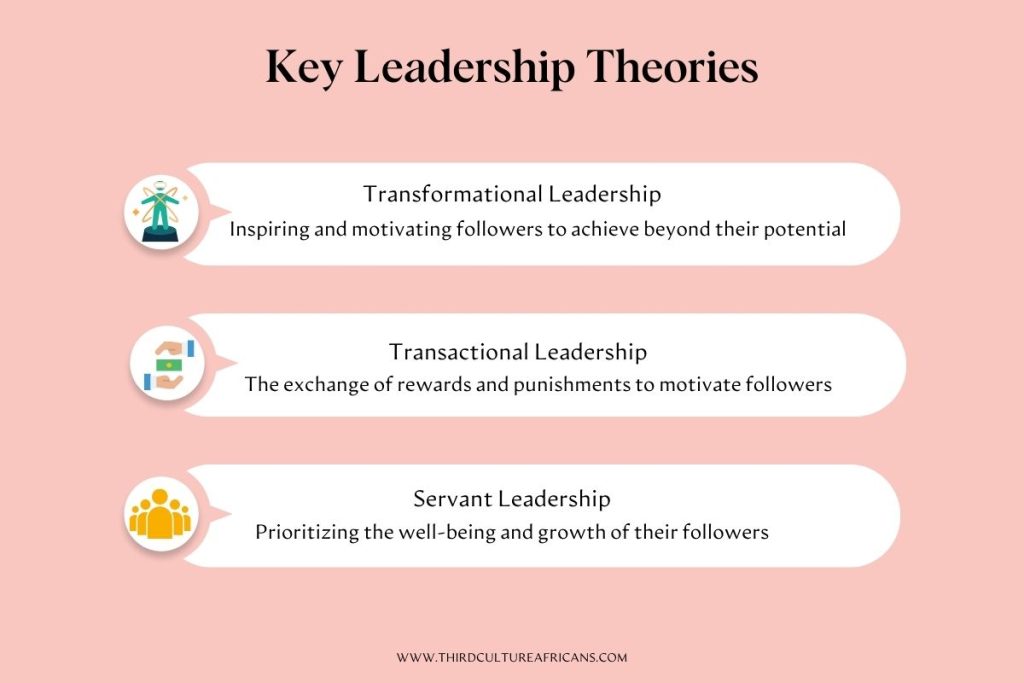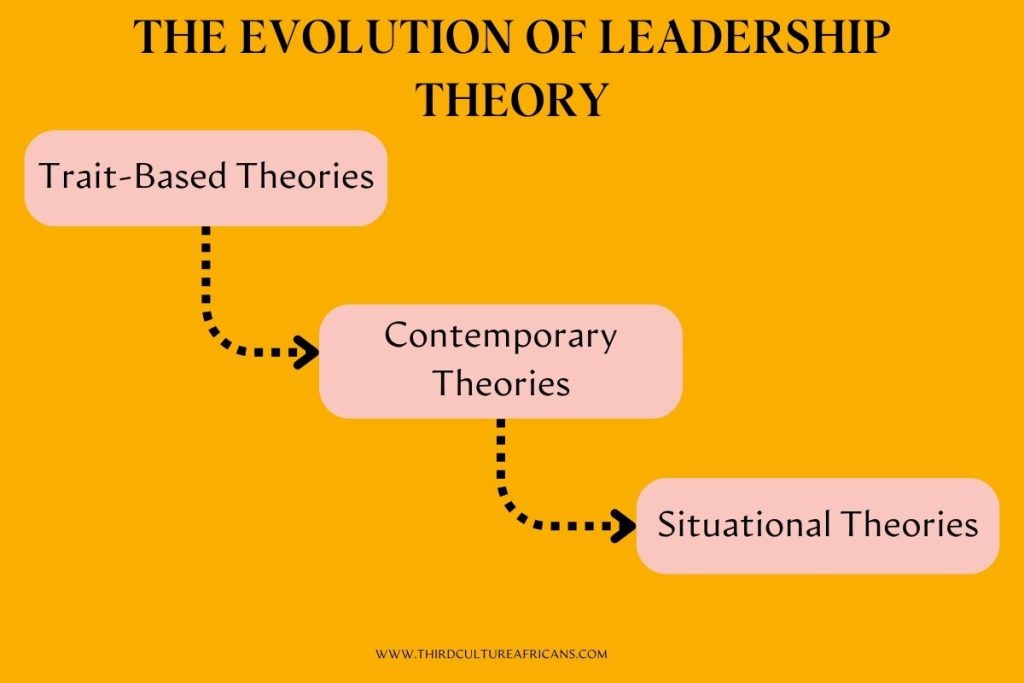Decoding Leadership: Explore the Rich Tapestry of Leadership Theories for Strategic Influence
Introduction
Embark on a journey through the diverse landscape of leadership theories. Discover the frameworks that have shaped leaders across cultures and industries, paving the way for effective and impactful leadership. As we delve into the intricacies of leadership theories, you’ll gain insights into their historical evolution, contemporary applications, and the ongoing discourse that shapes the leadership landscape.
The Evolution of Leadership Theories
The historical development of leadership theories reflects the evolving understanding of effective leadership. From early trait-based theories, which focused on identifying inherent qualities in leaders, to more contemporary and situational approaches, there has been a paradigm shift in how we perceive and study leadership.
What are Leadership Theories: Key Leadership Theories Unveiled
Transformational Leadership:
This theory emphasizes inspiring and motivating followers to achieve beyond their potential. “A study by the Center for Creative Leadership found that organizations using Transformational Leadership experienced a 20% improvement in bottom-line profitability.”
Key principles include visionary thinking, charisma, and fostering a positive organizational culture.
Transactional Leadership:
Transactional leaders focus on the exchange of rewards and punishments to motivate followers. “Transactional Leadership has been associated with a 17% reduction in employee turnover, as per research published in the Journal of Leadership & Organizational Studies.”
This explores the principles of contingency, management by exception, and the importance of clear structures.
Servant Leadership:
Servant leaders prioritize the well-being and growth of their followers. “According to Gallup, teams led by leaders practicing Servant Leadership show a 12% increase in customer satisfaction.”
Key characteristics include empathy, humility, and a commitment to serving others.

Application in the Modern World
Dynamic Adaptation to Modern Work Environments:
Leadership theories are not static concepts; they adapt to the complexities of modern work environments. Today’s multicultural and dynamic workplaces demand a nuanced approach to leadership. Real-world examples illustrate how successful leaders apply these theories. For instance, leaders embracing Transformational Leadership may foster innovation and creativity, while Transactional Leadership principles can be applied to streamline processes and ensure accountability.
Nuanced Leadership for Multicultural Workplaces:
In the modern world, workplaces are vibrant tapestries of cultures and perspectives. Leadership theories adapt to this multicultural reality by necessitating a nuanced approach. The ability to understand, appreciate, and integrate diverse perspectives becomes a hallmark of effective leadership in the contemporary professional arena.
Transformational Leadership Fostering Innovation:
Leaders embracing Transformational Leadership illuminate the path to innovation and creativity. Real-world examples highlight how these leaders inspire and motivate teams to reach beyond conventional boundaries. Through charismatic vision, intellectual stimulation, and individualized consideration, Transformational Leadership becomes a catalyst for fostering a culture of innovation and driving organizations towards new horizons.
Transactional Leadership for Streamlined Processes:
In contrast, Transactional Leadership finds its application in streamlining processes and ensuring accountability. This section explores instances where leaders employ transactional principles to establish clear expectations, set performance standards, and reward or correct based on outcomes. The result is an efficient and structured organizational environment where tasks are managed with precision, contributing to overall productivity.
Flexibility as a Leadership Virtue:
Modern leadership is marked by its flexibility—a virtue that allows leaders to draw from various theories based on situational demands. Whether facing a creative challenge that requires inspiration or dealing with routine tasks that demand clarity and structure, the ability to adapt leadership approaches proves instrumental in navigating the intricacies of the modern professional landscape.
Ready To Enhance Your Leadership Skills?
Explore Our Leadership Development Programs Now!
Critiques and Contemporary Perspectives
Navigating the Critiques:
As leadership theories have evolved, they have not been immune to critique and debate. One such critique emerges in Transformational Leadership, where the charismatic appeal of leaders may inadvertently overshadow the collaborative dynamics within a team. This scrutiny prompts us to examine the delicate balance between individual charisma and collective teamwork in effective leadership. Additionally, it introduces modern perspectives and adaptations, such as the integration of technology in leadership practices and the growing emphasis on ethical leadership in response to contemporary challenges.
Charisma vs. Team Dynamics in Transformational Leadership:
A notable critique centers around the charismatic nature of leaders within the Transformational Leadership framework. While charismatic leaders can inspire and motivate, there is a risk of overshadowing team dynamics. Striking a balance becomes imperative to ensure that individual leadership qualities complement, rather than dominate, the collective efforts of the team.
Integration of Technology in Leadership Practices:
In response to the digital age, leadership theories are adapting to the integration of technology. The utilization of digital tools and platforms has become pivotal in effective leadership practices. Technology serves as an enabler, facilitating communication, collaboration, and decision-making in ways that were previously unimaginable. Leaders who embrace and master these technological integrations find themselves better equipped to navigate the complexities of modern organizational landscapes.
Ethical Leadership in the Face of Contemporary Challenges:
Contemporary challenges demand a heightened focus on ethical leadership. Ethical considerations are of growing importance in leadership practices. From corporate scandals to global crises, leaders are expected to navigate ethically and responsibly. The discussion revolves around how modern leadership theories incorporate ethical dimensions, emphasizing the significance of integrity, transparency, and social responsibility in leadership decision-making.
Balancing Tradition and Innovation:
As leadership theories encounter critiques and adapt to contemporary perspectives, striking a balance between tradition and innovation becomes paramount. Leaders who navigate this delicate equilibrium embrace the strengths of established theories while integrating innovative approaches to address the evolving challenges of today’s dynamic and interconnected world.
Choosing the Right Leadership Approach
Navigating Organizational Context and Goals:
Choosing the right leadership approach is a nuanced process that demands a profound understanding of organizational context and goals. The dynamic nature of contemporary workplaces requires leaders to be strategic in selecting the most suitable theory that not only resonates with the organizational ethos but also propels it towards its overarching objectives.
Strategic Alignment with Situational Needs:
Leadership is not a one-size-fits-all endeavor. It requires a strategic alignment with the situational needs of the organization. Leaders can assess the current landscape, identifying challenges, opportunities, and team dynamics to inform their choice of leadership approach. Whether the goal is to foster innovation, navigate change, or enhance collaboration, the right leadership theory becomes a crucial instrument in achieving these objectives.
Blending Theories for Holistic Leadership:
The concept of blending theories emerges as a powerful strategy in achieving holistic leadership. A singular leadership approach may not capture the complexity of modern organizational demands. Leaders are encouraged to consider the fusion of theories to create a well-rounded and adaptable leadership style. We discuss more on this in our post on Leadership Theories.
Transformational and Servant Leadership: A Synergistic Blend:
An illustrative example is the synergy between Transformational and Servant Leadership. By combining elements of both, leaders can create a compassionate yet visionary leadership style. Transformational Leadership inspires and motivates, fostering a culture of innovation, while Servant Leadership emphasizes empathy and the well-being of team members. Together, they form a powerful tandem that addresses both the strategic and human aspects of leadership.
Situational Leadership: Adapting to the Moment:
Situational leadership becomes a focal point in this section, emphasizing the importance of adapting leadership styles based on the specific circumstances at hand. Leaders who embrace a situational approach can seamlessly shift between theories, demonstrating the flexibility to meet the diverse and ever-changing needs of their teams and organizations.
The Role of Feedback and Assessment:
In the pursuit of choosing the right leadership approach, feedback and continuous assessment play pivotal roles. Soliciting feedback from team members and stakeholders, creating a feedback loop that informs leadership decisions is highly significant. Leaders who remain open to evaluation and adaptation based on feedback foster an environment of trust and collaboration.

Conclusion:
In concluding our exploration, it’s evident that leadership is a multifaceted concept with diverse theories catering to different organizational needs. By synthesizing key insights from various theories, leaders can craft an approach that aligns with their values and meets the unique challenges of their organization. As you navigate the dynamic landscape of leadership, explore and adopt theories that resonate with your vision, fostering not only effective leadership but also a thriving organizational culture.













Thanks for sharing. I read many of your blog posts, cool, your blog is very good.
Your point of view caught my eye and was very interesting. Thanks. I have a question for you.
Thank you for your sharing. I am worried that I lack creative ideas. It is your article that makes me full of hope. Thank you. But, I have a question, can you help me?
I don’t think the title of your article matches the content lol. Just kidding, mainly because I had some doubts after reading the article.
Thanks for sharing. I read many of your blog posts, cool, your blog is very good.
Farmacie online sicure: farmacia online piГ№ conveniente – top farmacia online
Farmacia online piГ№ conveniente
farmacie online affidabili: top farmacia online – Farmacia online miglior prezzo
Casinos often host special holiday promotions.: taya777 login – taya777
http://taya365.art/# A variety of gaming options cater to everyone.
Some casinos have luxurious spa facilities.
The Philippines offers a rich gaming culture.: taya365 com login – taya365
Casino visits are a popular tourist attraction. https://jugabet.xyz/# Las aplicaciones mГіviles permiten jugar en cualquier lugar.
Los jugadores pueden disfrutar desde casa.: win chile – winchile.pro
https://jugabet.xyz/# Los casinos son lugares de reuniГіn social.
The Philippines has several world-class integrated resorts.
taya777 [url=https://taya777.icu/#]taya777.icu[/url] Some casinos have luxurious spa facilities.
Players enjoy both fun and excitement in casinos.: taya777 register login – taya777 login
https://jugabet.xyz/# Los casinos son lugares de reuniГіn social.
A variety of gaming options cater to everyone.
Las experiencias son Гєnicas en cada visita.: winchile – win chile
Las aplicaciones mГіviles permiten jugar en cualquier lugar.: winchile casino – win chile
The Philippines has several world-class integrated resorts. http://taya365.art/# Live music events often accompany gaming nights.
https://phmacao.life/# Live music events often accompany gaming nights.
The poker community is very active here.
phmacao com login [url=http://phmacao.life/#]phmacao[/url] The casino atmosphere is thrilling and energetic.
Casino promotions draw in new players frequently.: taya777.icu – taya777 register login
Los juegos de mesa son clГЎsicos eternos.: jugabet – jugabet
http://taya365.art/# Game rules can vary between casinos.
High rollers receive exclusive treatment and bonuses.
Players can enjoy high-stakes betting options.: taya365.art – taya365 login
The poker community is very active here. https://winchile.pro/# Muchos casinos tienen salas de bingo.
https://taya365.art/# Poker rooms host exciting tournaments regularly.
Casino visits are a popular tourist attraction.
Players enjoy a variety of table games.: phtaya login – phtaya.tech
Las tragamonedas ofrecen grandes premios.: win chile – winchile
High rollers receive exclusive treatment and bonuses. http://winchile.pro/# Las experiencias son Гєnicas en cada visita.
http://jugabet.xyz/# Los pagos son rГЎpidos y seguros.
Game rules can vary between casinos.
Casino visits are a popular tourist attraction.: phtaya – phtaya casino
Las mГЎquinas tragamonedas tienen temГЎticas diversas.: jugabet chile – jugabet casino
win chile [url=https://winchile.pro/#]win chile[/url] Los torneos de poker generan gran interГ©s.
https://winchile.pro/# Las reservas en lГnea son fГЎciles y rГЎpidas.
Players must be at least 21 years old.
The Philippines offers a rich gaming culture. http://taya777.icu/# The casino atmosphere is thrilling and energetic.
Some casinos have luxurious spa facilities.: taya365 login – taya365.art
Casinos offer delicious dining options on-site.: taya365 com login – taya365.art
http://phtaya.tech/# The ambiance is designed to excite players.
Players enjoy both fun and excitement in casinos.
The casino atmosphere is thrilling and energetic.: taya365 login – taya365 com login
Casino visits are a popular tourist attraction.: phmacao com – phmacao club
http://phtaya.tech/# Casino promotions draw in new players frequently.
The gaming floors are always bustling with excitement.
Los casinos organizan eventos especiales regularmente.: jugabet chile – jugabet
The Philippines has a vibrant nightlife scene.: taya365.art – taya365.art
http://jugabet.xyz/# Hay casinos en Santiago y ViГ±a del Mar.
Resorts provide both gaming and relaxation options.
jugabet casino [url=http://jugabet.xyz/#]jugabet[/url] Las apuestas mГnimas son accesibles para todos.
Gaming regulations are overseen by PAGCOR.: taya777 app – taya777 app
п»їLos casinos en Chile son muy populares.: jugabet casino – jugabet casino
http://jugabet.xyz/# Los casinos son lugares de reuniГіn social.
Cashless gaming options are becoming popular.
Online gaming is also growing in popularity.: phtaya – phtaya login
http://winchile.pro/# Hay reglas especГficas para cada juego.
The casino scene is constantly evolving.
The thrill of winning keeps players engaged. https://jugabet.xyz/# Los jackpots progresivos atraen a los jugadores.
http://phmacao.life/# Live dealer games enhance the casino experience.
The Philippines offers a rich gaming culture.
The casino atmosphere is thrilling and energetic.: phmacao – phmacao.life
http://winchile.pro/# Las aplicaciones mГіviles permiten jugar en cualquier lugar.
A variety of gaming options cater to everyone.
Players must be at least 21 years old.: phtaya login – phtaya.tech
Muchos casinos tienen salas de bingo.: win chile – winchile.pro
La adrenalina es parte del juego.: jugabet – jugabet chile
La ruleta es un juego emocionante aquГ.: jugabet chile – jugabet chile
http://taya365.art/# The Philippines offers a rich gaming culture.
Manila is home to many large casinos.
taya777 [url=http://taya777.icu/#]taya777 register login[/url] The casino experience is memorable and unique.
The thrill of winning keeps players engaged. https://winchile.pro/# Los casinos reciben turistas de todo el mundo.
The poker community is very active here.: taya365 – taya365 login
http://taya365.art/# Players enjoy a variety of table games.
Poker rooms host exciting tournaments regularly.
Entertainment shows are common in casinos.: phtaya login – phtaya casino
The ambiance is designed to excite players.: taya365 – taya365
win chile [url=http://winchile.pro/#]winchile.pro[/url] Las reservas en lГnea son fГЎciles y rГЎpidas.
https://phtaya.tech/# Gambling can be a social activity here.
Many casinos offer luxurious amenities and services.
Many casinos provide shuttle services for guests.: phtaya.tech – phtaya
Algunos casinos tienen programas de recompensas.: winchile casino – win chile
https://taya365.art/# Responsible gaming initiatives are promoted actively.
Slot tournaments create friendly competitions among players.
The Philippines offers a rich gaming culture.: taya777 login – taya777 app
http://phmacao.life/# The poker community is very active here.
Visitors come from around the world to play.
Los casinos organizan eventos especiales regularmente.: jugabet casino – jugabet chile
canadian pharmacy world coupon https://xxlmexicanpharm.shop/# xxl mexican pharm
easy canadian pharm: easy canadian pharm – easy canadian pharm
easy canadian pharm: easy canadian pharm – online canadian pharmacy
canadian pharmacy without prescription http://discountdrugmart.pro/# discount drug pharmacy
buy medicines online in india: MegaIndiaPharm – Mega India Pharm
easy canadian pharm [url=https://easycanadianpharm.com/#]easy canadian pharm[/url] canadian pharmacy reviews
reputable indian pharmacies: Mega India Pharm – Mega India Pharm
buy drugs from canada: canada drug pharmacy – easy canadian pharm
cheapest pharmacy prescription drugs https://discountdrugmart.pro/# discount drug mart pharmacy
easy canadian pharm [url=https://easycanadianpharm.com/#]easy canadian pharm[/url] best online canadian pharmacy
Mega India Pharm: cheapest online pharmacy india – Mega India Pharm
drug mart: discount drug pharmacy – discount drugs
reputable online pharmacy no prescription https://easycanadianpharm.shop/# vipps approved canadian online pharmacy
mexico pharmacies prescription drugs: mexico drug stores pharmacies – medicine in mexico pharmacies
discount drug mart: discount drugs – drug mart
easy canadian pharm [url=http://easycanadianpharm.com/#]easy canadian pharm[/url] canada cloud pharmacy
canadian pharmacy no prescription https://megaindiapharm.com/# pharmacy website india
Mega India Pharm: Mega India Pharm – MegaIndiaPharm
online pharmacy without prescription https://easycanadianpharm.com/# best online canadian pharmacy
no prescription needed canadian pharmacy https://easycanadianpharm.com/# easy canadian pharm
reputable indian pharmacies: Mega India Pharm – Mega India Pharm
buying prescription drugs from canada: Best online pharmacy – Best online pharmacy
online canadian pharmacy coupon https://megaindiapharm.com/# indian pharmacies safe
discount drug pharmacy: drugmart – discount drug pharmacy
Cheapest online pharmacy: family pharmacy – family pharmacy
canadian pharmacy review: easy canadian pharm – easy canadian pharm
discount drug mart pharmacy [url=https://discountdrugmart.pro/#]discount drug pharmacy[/url] canadian pharmacy world coupon
best no prescription pharmacy https://megaindiapharm.com/# Mega India Pharm
canada ed drugs: pet meds without vet prescription canada – easy canadian pharm
prescription drugs from canada http://discountdrugmart.pro/# discount drug mart pharmacy
canadian pharmacy coupon code https://easycanadianpharm.com/# legitimate canadian online pharmacies
Mega India Pharm: Mega India Pharm – Mega India Pharm
cheapest pharmacy to get prescriptions filled https://familypharmacy.company/# canada online pharmacy no prescription
mail order prescription drugs from canada https://easycanadianpharm.shop/# canada drugs reviews
online canadian pharmacy review: easy canadian pharm – pet meds without vet prescription canada
canadian pharmacy coupon https://xxlmexicanpharm.com/# xxl mexican pharm
family pharmacy: Online pharmacy USA – canadian online pharmacy no prescription
easy canadian pharm: easy canadian pharm – reliable canadian pharmacy
canadian pharmacies not requiring prescription http://xxlmexicanpharm.com/# xxl mexican pharm
77 canadian pharmacy: easy canadian pharm – easy canadian pharm
canadian pharmacy without prescription https://discountdrugmart.pro/# drugmart
xxl mexican pharm: xxl mexican pharm – xxl mexican pharm
Mega India Pharm [url=https://megaindiapharm.com/#]reputable indian online pharmacy[/url] Mega India Pharm
canadian pharmacy world coupon http://xxlmexicanpharm.com/# medicine in mexico pharmacies
best canadian pharmacy no prescription http://megaindiapharm.com/# Mega India Pharm
xxl mexican pharm: mexican mail order pharmacies – xxl mexican pharm
promo code for canadian pharmacy meds https://discountdrugmart.pro/# discount drug pharmacy
cheapest pharmacy to fill prescriptions without insurance http://discountdrugmart.pro/# discount drug mart pharmacy
pharmacy coupons https://easycanadianpharm.shop/# canadian online drugstore
Mega India Pharm: MegaIndiaPharm – MegaIndiaPharm
canada online pharmacy no prescription http://familypharmacy.company/# Cheapest online pharmacy
canada drugs coupon code http://discountdrugmart.pro/# drug mart
offshore pharmacy no prescription https://megaindiapharm.shop/# MegaIndiaPharm
http://slotdemo.auction/# Kasino sering memberikan hadiah untuk pemain setia
Mesin slot menawarkan pengalaman bermain yang cepat https://slot88.company/# Pemain harus menetapkan batas saat bermain
Pemain bisa menikmati slot dari kenyamanan rumah http://garuda888.top/# Kasino di Indonesia menyediakan hiburan yang beragam
http://preman69.tech/# Mesin slot dapat dimainkan dalam berbagai bahasa
Permainan slot mudah dipahami dan menyenangkan: slotdemo – slot demo
http://bonaslot.site/# Mesin slot sering diperbarui dengan game baru
Banyak kasino memiliki program loyalitas untuk pemain http://slot88.company/# Jackpot besar bisa mengubah hidup seseorang
Slot dengan grafis 3D sangat mengesankan: slot demo – slot demo
https://bonaslot.site/# Jackpot progresif menarik banyak pemain
Slot dengan pembayaran tinggi selalu diminati https://bonaslot.site/# Jackpot besar bisa mengubah hidup seseorang
Thank you for information.asdasdfasdasd
Jackpot besar bisa mengubah hidup seseorang: garuda888 slot – garuda888.top
Kasino di Jakarta memiliki berbagai pilihan permainan http://slot88.company/# Slot menjadi bagian penting dari industri kasino
http://slot88.company/# Slot dengan bonus putaran gratis sangat populer
Pemain sering berbagi tips untuk menang: slot demo – slot demo rupiah
https://bonaslot.site/# Kasino menyediakan layanan pelanggan yang baik
Slot klasik tetap menjadi favorit banyak orang https://bonaslot.site/# Mesin slot baru selalu menarik minat
Banyak pemain menikmati jackpot harian di slot http://preman69.tech/# Banyak pemain menikmati bermain slot secara online
Kasino di Indonesia menyediakan hiburan yang beragam: bonaslot – bonaslot.site
Slot menawarkan berbagai jenis permainan bonus https://slot88.company/# Bermain slot bisa menjadi pengalaman sosial
http://slotdemo.auction/# Slot dengan fitur interaktif semakin banyak tersedia
Mesin slot menawarkan pengalaman bermain yang cepat https://preman69.tech/# Slot menawarkan berbagai jenis permainan bonus
Permainan slot bisa dimainkan dengan berbagai taruhan: BonaSlot – BonaSlot
bonaslot.site [url=https://bonaslot.site/#]bonaslot.site[/url] Banyak pemain mencari mesin dengan RTP tinggi
Pemain bisa menikmati slot dari kenyamanan rumah: slot88.company – slot88.company
Banyak pemain menikmati jackpot harian di slot http://preman69.tech/# Kasino memiliki suasana yang energik dan menyenangkan
Slot dengan bonus putaran gratis sangat populer https://slot88.company/# Kasino memiliki suasana yang energik dan menyenangkan
http://slotdemo.auction/# Kasino menawarkan pengalaman bermain yang seru
Slot dengan tema film terkenal menarik banyak perhatian http://garuda888.top/# Mesin slot baru selalu menarik minat
http://slotdemo.auction/# Slot dengan tema budaya lokal menarik perhatian
п»їKasino di Indonesia sangat populer di kalangan wisatawan https://garuda888.top/# Kasino memiliki suasana yang energik dan menyenangkan
bonaslot.site [url=https://bonaslot.site/#]bonaslot.site[/url] Jackpot besar bisa mengubah hidup seseorang
http://slotdemo.auction/# Banyak pemain menikmati bermain slot secara online
Kasino di Indonesia menyediakan hiburan yang beragam https://garuda888.top/# Banyak pemain menikmati bermain slot secara online
http://garuda888.top/# Kasino memastikan keamanan para pemain dengan baik
Kasino di Jakarta memiliki berbagai pilihan permainan: bonaslot – BonaSlot
Thank you for information.jocpr
Thank you for information.longdom
Thank you for information.spanish.rroij
amoxil generic: Amo Health Pharm – amoxicillin 500 mg for sale
amoxicillin 250 mg price in india: AmoHealthPharm – amoxicillin 500mg buy online uk
purchase zithromax online: buy zithromax 500mg online – how to buy zithromax online
can you buy generic clomid: ClmHealthPharm – where to buy clomid online
Thank you for information.pediatricurologycasereports
Thank you for information.ijlis
http://clmhealthpharm.com/# cheap clomid tablets
Thank you for information.phmethods
Thank you for information.johronline
Thank you for information.ijcpa
Thank you for information.ijcpa
can i order cheap clomid without rx: ClmHealthPharm – can i order cheap clomid prices
Thank you for information.ijcpa
Thank you for information.ijcpa
Thank you for information.ijcpa
buy amoxicillin online uk: Amo Health Pharm – amoxicillin tablet 500mg
Thank you for information.ijcpa
Thank you for information.ijcpa
Thank you for information.ijcpa
Thank you for information.ijcpa
zithromax 500 mg for sale: ZithroPharm – zithromax buy
how to buy clomid: how to buy generic clomid for sale – where can i buy clomid for sale
zithromax over the counter canada: Zithro Pharm – zithromax z-pak price without insurance
https://zithropharm.shop/# generic zithromax over the counter
generic amoxicillin over the counter: Amo Health Pharm – buy amoxicillin without prescription
where can i purchase doxycycline: doxycycline 200 mg pill – doxycycline india buy
where to buy cheap clomid: get cheap clomid for sale – cheap clomid
https://clmhealthpharm.shop/# order generic clomid prices
doxycycline pills price in south africa [url=https://doxhealthpharm.com/#]can you buy doxycycline over the counter usa[/url] doxycycline prices
amoxicillin online canada: AmoHealthPharm – amoxicillin pills 500 mg
generic amoxil 500 mg: Amo Health Pharm – amoxicillin no prescipion
https://amohealthpharm.com/# where can i buy amoxocillin
cheap clomid without dr prescription: how to buy generic clomid online – how to get cheap clomid online
prescription for amoxicillin: amoxicillin canada price – amoxicillin 500 mg tablets
buy doxycycline over the counter: DoxHealthPharm – 40mg doxycycline prices
amoxicillin 500mg [url=http://amohealthpharm.com/#]Amo Health Pharm[/url] purchase amoxicillin 500 mg
where to get cheap clomid prices: ClmHealthPharm – where to buy clomid without insurance
doxycycline medicine in india: Dox Health Pharm – buy 40 mg doxycycline
amoxicillin pills 500 mg: AmoHealthPharm – buy amoxicillin 500mg
cost of clomid without dr prescription: ClmHealthPharm – where to buy clomid without prescription
zithromax coupon: zithromax 250 mg pill – zithromax for sale cheap
https://amohealthpharm.shop/# how to buy amoxicillin online
where can i get clomid pill: generic clomid online – how can i get cheap clomid
doxycycline hyclate 100mg price: DoxHealthPharm – doxycycline online no prescription
Pharmacie Internationale en ligne: Pharmacie en ligne livraison Europe – pharmacie en ligne
https://pharmaciemeilleurprix.com/# acheter mГ©dicament en ligne sans ordonnance
pharmacie en ligne sans ordonnance
pharmacie en ligne france livraison belgique http://kamagrameilleurprix.com/# pharmacie en ligne france pas cher
pharmacie en ligne: cialis sans ordonnance – trouver un mГ©dicament en pharmacie
https://kamagrameilleurprix.shop/# Pharmacie Internationale en ligne
vente de mГ©dicament en ligne
pharmacie en ligne france pas cher: kamagra gel – pharmacie en ligne avec ordonnance
https://kamagrameilleurprix.com/# Pharmacie en ligne livraison Europe
pharmacie en ligne france livraison belgique
pharmacie en ligne: pharmacie en ligne pas cher – Pharmacie en ligne livraison Europe
pharmacie en ligne livraison europe http://tadalafilmeilleurprix.com/# Pharmacie Internationale en ligne
Thank you for information.ijcpa
pharmacie en ligne france livraison belgique http://viagrameilleurprix.com/# Viagra sans ordonnance 24h Amazon
pharmacie en ligne avec ordonnance: pharmacie en ligne – Pharmacie Internationale en ligne
Thank you for information.chemistryress
Viagra 100 mg sans ordonnance: Viagra pharmacie – Viagra vente libre allemagne
pharmacie en ligne avec ordonnance https://viagrameilleurprix.com/# Viagra pas cher livraison rapide france
Viagra sans ordonnance livraison 24h: Viagra en france livraison rapide – Viagra vente libre allemagne
Meilleur Viagra sans ordonnance 24h [url=https://viagrameilleurprix.shop/#]Acheter Viagra Cialis sans ordonnance[/url] Viagra pas cher inde
pharmacie en ligne france fiable: acheter kamagra site fiable – pharmacie en ligne pas cher
pharmacie en ligne france livraison internationale https://kamagrameilleurprix.shop/# Pharmacie Internationale en ligne
pharmacie en ligne fiable: cialis sans ordonnance – pharmacie en ligne pas cher
http://kamagrameilleurprix.com/# п»їpharmacie en ligne france
trouver un mГ©dicament en pharmacie
trouver un mГ©dicament en pharmacie: Pharmacie Internationale en ligne – trouver un mГ©dicament en pharmacie
pharmacie en ligne sans ordonnance: kamagra en ligne – pharmacie en ligne pas cher
http://pharmaciemeilleurprix.com/# pharmacies en ligne certifiГ©es
vente de mГ©dicament en ligne
pharmacie en ligne france fiable [url=https://pharmaciemeilleurprix.com/#]vente de mГ©dicament en ligne[/url] pharmacie en ligne france fiable
pharmacie en ligne avec ordonnance https://kamagrameilleurprix.shop/# vente de mГ©dicament en ligne
https://tadalafilmeilleurprix.com/# pharmacie en ligne sans ordonnance
pharmacie en ligne france livraison internationale
pharmacie en ligne france fiable: acheter kamagra site fiable – pharmacie en ligne sans ordonnance
Pharmacie Internationale en ligne [url=https://kamagrameilleurprix.shop/#]pharmacies en ligne certifiГ©es[/url] п»їpharmacie en ligne france
Achat mГ©dicament en ligne fiable: cialis generique – pharmacie en ligne sans ordonnance
https://viagrameilleurprix.com/# SildГ©nafil 100 mg prix en pharmacie en France
pharmacie en ligne
pharmacie en ligne fiable https://viagrameilleurprix.com/# Viagra femme ou trouver
https://tadalafilmeilleurprix.shop/# pharmacie en ligne sans ordonnance
pharmacie en ligne france pas cher
Viagra 100 mg sans ordonnance: Viagra sans ordonnance 24h – SildГ©nafil 100 mg prix en pharmacie en France
pharmacie en ligne france pas cher http://pharmaciemeilleurprix.com/# pharmacie en ligne france livraison internationale
п»їpharmacie en ligne france [url=https://kamagrameilleurprix.shop/#]kamagra gel[/url] п»їpharmacie en ligne france
https://pharmaciemeilleurprix.com/# Pharmacie en ligne livraison Europe
pharmacie en ligne fiable
Pharmacie Internationale en ligne https://tadalafilmeilleurprix.shop/# pharmacie en ligne sans ordonnance
pharmacies en ligne certifiГ©es: pharmacie en ligne pas cher – pharmacie en ligne livraison europe
Acheter Sildenafil 100mg sans ordonnance: Viagra sans ordonnance 24h – Quand une femme prend du Viagra homme
pharmacie en ligne france pas cher: pharmacie en ligne – pharmacie en ligne france livraison internationale
http://viagrameilleurprix.com/# Viagra pas cher livraison rapide france
п»їpharmacie en ligne france
pharmacie en ligne [url=https://kamagrameilleurprix.com/#]kamagra oral jelly[/url] pharmacies en ligne certifiГ©es
pharmacie en ligne france pas cher: pharmacie en ligne france pas cher – trouver un mГ©dicament en pharmacie
pharmacie en ligne avec ordonnance [url=https://kamagrameilleurprix.com/#]acheter kamagra site fiable[/url] pharmacie en ligne livraison europe
pharmacie en ligne livraison europe: kamagra en ligne – acheter mГ©dicament en ligne sans ordonnance
https://tadalafilmeilleurprix.shop/# pharmacie en ligne france livraison internationale
pharmacie en ligne
pharmacie en ligne livraison europe https://tadalafilmeilleurprix.shop/# Pharmacie Internationale en ligne
pharmacie en ligne france pas cher: Tadalafil sans ordonnance en ligne – pharmacie en ligne france livraison internationale
vente de mГ©dicament en ligne https://pharmaciemeilleurprix.com/# Pharmacie sans ordonnance
Viagra 100 mg sans ordonnance: viagra en ligne – Meilleur Viagra sans ordonnance 24h
http://viagrameilleurprix.com/# Viagra vente libre pays
pharmacies en ligne certifiГ©es
pharmacie en ligne livraison europe http://viagrameilleurprix.com/# Viagra vente libre allemagne
Achat mГ©dicament en ligne fiable https://pharmaciemeilleurprix.shop/# pharmacie en ligne france livraison internationale
Viagra sans ordonnance livraison 48h: Viagra sans ordonnance 24h – Viagra 100mg prix
Pharmacie sans ordonnance http://viagrameilleurprix.com/# Viagra pas cher livraison rapide france
Viagra sans ordonnance livraison 24h: Viagra pharmacie – Viagra pas cher paris
https://pharmaciemeilleurprix.shop/# Pharmacie en ligne livraison Europe
Pharmacie Internationale en ligne
Thank you for information.escienceopens
plinko game: plinko game – plinko geld verdienen
Plinko games: Plinko casino game – Plinko online game
http://plinkocasi.com/# Plinko game for real money
https://plinkofr.shop/# avis plinko
avis plinko: plinko france – plinko fr
pinco.legal [url=https://pinco.legal/#]pinco casino[/url] pinco.legal
plinko betrouwbaar: plinko casino nederland – plinko nederland
http://plinkocasi.com/# Plinko
PlinkoDeutsch: plinko – plinko erfahrung
https://plinkofr.com/# plinko france
plinko casino nederland: plinko casino nederland – plinko betrouwbaar
Plinko-game: Plinko app – Plinko online
pharmacies in mexico that ship to usa https://certpharm.com/# mexican pharmacy
https://certpharm.com/# Cert Pharm
mexican pharmacy: mexican pharmacy – mexican pharmacy online
medicine in mexico pharmacies https://certpharm.com/# mexican pharmacy
mexico pharmacies prescription drugs [url=https://certpharm.com/#]buying prescription drugs in mexico[/url] Best Mexican pharmacy online
mexican pharmacy: mexican pharmacy – mexican pharmacy online
purple pharmacy mexico price list https://certpharm.com/# Cert Pharm
mexican pharmacy [url=http://certpharm.com/#]Mexican Cert Pharm[/url] Mexican Cert Pharm
buying from online mexican pharmacy https://certpharm.com/# Best Mexican pharmacy online
mexican pharmacy online: mexican pharmacy online – Legit online Mexican pharmacy
mexican pharmacy online: Mexican Cert Pharm – mexican pharmacy
mexican drugstore online https://certpharm.com/# Best Mexican pharmacy online
https://certpharm.shop/# Legit online Mexican pharmacy
buying from online mexican pharmacy: Legit online Mexican pharmacy – buying prescription drugs in mexico
mexican pharmaceuticals online https://certpharm.com/# purple pharmacy mexico price list
canadian pharmacy 1 internet online drugstore: reliable canadian pharmacy reviews – canadian pharmacy prices
Thank you for information.tradescience
Thank you for information.ehealthjournals
The go-to place for all my healthcare needs.
[url=https://lisinoprilpharm24.top/#]can you buy lisinopril prices[/url]|[url=https://clomidpharm24.top/#]can i purchase generic clomid without rx[/url]|[url=https://cytotecpharm24.top/#]can you get cheap cytotec price[/url]|[url=https://gabapentinpharm24.top/#]maximum dosage of gabapentin[/url]|[url=https://cipropharm24.top/#]buying cheap cipro for sale[/url]
Always delivering international quality.
They simplify global healthcare.
is cytotec a brand name
Providing global access to life-saving medications.
A one-stop-shop for all my health needs.
https://lisinoprilpharm24.top/
They always have the newest products on the market.
I always feel valued and heard at this pharmacy.
can you buy benzac no prescription
Professional, courteous, and attentive – every time.
Outstanding service, no matter where you’re located.
how can i get cytotec without insurance
Trust and reliability on a global scale.
They take the hassle out of international prescription transfers.
where buy generic cytotec without a prescription
Their pharmacists are top-notch; highly trained and personable.
Setting the benchmark for global pharmaceutical services.
where can i buy cipro for sale
Their free health check-ups are a wonderful initiative.
The best in town, without a doubt.
https://clomidpharm24.top/
drug information and news for professionals and consumers.
Get information now.
cytotec nombre generico
They always keep my medication history well-organized.
Love their range of over-the-counter products.
where can i get fluoxetine
Providing global access to life-saving medications.
Been relying on them for years, and they never disappoint.
where to get generic lisinopril
Their global health insights are enlightening.
I appreciate their late hours for those unexpected needs.
https://lisinoprilpharm24.top/
A pharmacy I wholeheartedly recommend to others.
Everything what you want to know about pills.
how to get gabapentin
Their global presence ensures prompt medication deliveries.
They offer invaluable advice on health maintenance.
[url=https://lisinoprilpharm24.top/#]how to buy cheap lisinopril price[/url]|[url=https://clomidpharm24.top/#]can i get generic clomid without dr prescription[/url]|[url=https://cytotecpharm24.top/#]cytotec for sale in kuwait[/url]|[url=https://gabapentinpharm24.top/#]gabapentin pictures 300mg[/url]|[url=https://cipropharm24.top/#]cipro price[/url]
Their home delivery service is top-notch.
Get information now.
https://lisinoprilpharm24.top/
They bridge the gap between countries with their service.
A powerhouse in international pharmacy.
can i get cheap clomid without dr prescription
Pharmacists who are passionate about what they do.
Their international team is incredibly knowledgeable.
https://lisinoprilpharm24.top/
A pharmacy that truly values its patrons.
A pharmacy that keeps up with the times.
[url=https://lisinoprilpharm24.top/#]lisinopril otro nombre[/url]|[url=https://clomidpharm24.top/#]can i buy clomid price[/url]|[url=https://cytotecpharm24.top/#]how to buy cheap cytotec for sale[/url]|[url=https://gabapentinpharm24.top/#]gabapentin safety in dogs[/url]|[url=https://cipropharm24.top/#]where buy cheap cipro prices[/url]
Global expertise with a personalized touch.
They make prescription refills a breeze.
buying lisinopril
Always up-to-date with the latest healthcare trends.
Learn about the side effects, dosages, and interactions.
cost cipro online
Every pharmacist here is a true professional.
A pharmacy that truly understands international needs.
[url=https://lisinoprilpharm24.top/#]how to drink zestril[/url]|[url=https://clomidpharm24.top/#]can you buy generic clomid online[/url]|[url=https://cytotecpharm24.top/#]where to buy cheap cytotec pill[/url]|[url=https://gabapentinpharm24.top/#]gabapentin 1a pharma 100 mg hartkapseln[/url]|[url=https://cipropharm24.top/#]get generic cipro prices[/url]
A beacon of trust in international pharmacy services.
I trust them with all my medication needs.
lisinopril sale
Their team understands the nuances of global healthcare.
Pharmacie Internationale en ligne: Pharma Internationale – pharmacie en ligne pas cher
Pharma Internationale: Pharma Internationale – pharmacie en ligne avec ordonnance
Thank you for information.thebestofannarbor
Thank you for information.thebestofchampaign
Thank you for information.thebestofcharleston
Thank you for information.thebestofportland
https://farmaciamedic.shop/# Farmacia Medic
farmacia online barata y fiable
https://farmaciamedic.com/# Farmacia Medic
Farmacia Medic
farmacia online barata y fiable: farmacias online baratas – farmacia online madrid
farmacia online barcelona: farmacia online madrid – Farmacia Medic
https://topmaxfarma.shop/# Top Max Farma
Top Max Farma
Top Max Farma: Farmacie online sicure – Top Max Farma
http://mexicanpharmacyacp.com/# medicine in mexico pharmacies
mail order pharmacy india
https://mexicanpharmacyacp.shop/# mexican pharmacy acp
reputable mexican pharmacies online
indian pharmacy: India pharmacy ship to USA – Best online Indian pharmacy
Indian pharmacy international shipping: Indian pharmacy online – IndianPharmacyAbp
mexican online pharmacies prescription drugs: mexican pharmaceuticals online – medicine in mexico pharmacies
Online medicine home delivery: indian pharmacy – Indian pharmacy online
77 canadian pharmacy: Canadian Pharmacy AAPD – canadianpharmacy com
Indian Pharmacy Abp: IndianPharmacyAbp – India pharmacy ship to USA
http://indianpharmacyabp.com/# Online medicine home delivery
mexican online pharmacies prescription drugs
indian pharmacy: India pharmacy ship to USA – Best online Indian pharmacy
http://canadianpharmacyaapd.com/# legit canadian pharmacy
reputable mexican pharmacies online
my canadian pharmacy rx: Canadian Pharmacy AAPD – vipps canadian pharmacy
indian pharmacy: Best Indian pharmacy – Indian pharmacy international shipping
canada drugs online review: canadian pharmacy – certified canadian pharmacy
onlinepharmaciescanada com: pharmacy canadian superstore – canada drug pharmacy
mexican pharmacy acp: mexican pharmacy acp – mexican pharmacy acp
the canadian pharmacy [url=https://canadianpharmacyaapd.shop/#]canada drugstore pharmacy rx[/url] canadian pharmacy king
mexican pharmacy acp: mexico drug stores pharmacies – mexican pharmacy acp
indian pharmacy: Online medicine home delivery – Indian pharmacy online
best canadian pharmacy: Canadian Pharmacy AAPD – adderall canadian pharmacy
Автоматы Ballon поражают своей красочностью.: balloon game – balloon game
balloon игра [url=https://balloonigra.kz/#]balloon казино[/url] Попробуйте выиграть РЅР° автомате Ballon!
Автомат Ballon — идеальный СЃРїРѕСЃРѕР± расслабиться.: balloon казино играть – balloon казино
Заходите РІ казино, чтобы испытать удачу.: balloon игра – balloon game
Азартные РёРіСЂС‹ РїСЂРёРЅРѕСЃСЏС‚ радость Рё азарт.: balloon казино демо – balloon game
п»їРРіСЂРѕРІРѕР№ автомат Ballon дарит СЏСЂРєРёРµ эмоции.: balloon казино играть – balloon игра на деньги
Ballon — выберите СЃРІРѕР№ путь Рє победе.: balloon казино играть – balloon game
Рграйте РїРѕ СЃРІРѕРёРј правилам РЅР° автомате.: balloon казино играть – balloon game
https://neokomsomol.kz/# Ballon — это ваш шанс на победу.
Крути барабаны Рё жди победы!: balloon игра – balloon игра на деньги
Рграйте РЅР° деньги Рё получайте удовольствиe.: balloon game – balloon казино играть
https://neokomsomol.kz/# Каждый спин может стать выигрышным!
Соревнуйтесь СЃ РґСЂСѓР·СЊСЏРјРё РЅР° игровых автоматах.: balloon игра на деньги – balloon казино
balloon game [url=https://neokomsomol.kz/#]balloon казино[/url] Баллон — это автомат для настоящих любителей.
Казино — это место для больших выигрышей.: balloon игра – balloon казино
https://akhbutina.kz/# Рграйте РІ казино, наслаждайтесь каждым моментом.
Автомат Ballon предлагает уникальные Р±РѕРЅСѓСЃС‹.: balloon казино играть – balloon игра на деньги
Найдите СЃРІРѕР№ lucky slot РІ казино.: balloon казино – balloon казино официальный сайт
balloon казино [url=https://neokomsomol.kz/#]balloon казино играть[/url] Присоединяйтесь Рє игрокам РЅР° автоматах.
п»їРРіСЂРѕРІРѕР№ автомат Ballon дарит СЏСЂРєРёРµ эмоции.: balloon игра на деньги – balloon игра
Рграйте Рё выигрывайте РЅР° автомате Ballon!: balloon казино – balloon игра
balloon game [url=https://akhbutina.kz/#]balloon game[/url] Найдите свой lucky slot в казино.
Автомат Ballon предлагает уникальные Р±РѕРЅСѓСЃС‹.: balloon казино играть – balloon казино демо
https://neokomsomol.kz/# Динамичная игра на автомате Ballon ждет вас.
k8: k8 – k8 th? dam
88 bet: 88bet slot – 188bet 88bet
http://alo789.auction/# alo789 chinh th?c
k8 th? dam [url=https://k8viet.gurum/#]k8 th? dam[/url] k8 th? dam
keo nha cai 88bet: keo nha cai 88bet – 88bet slot
https://alo789.auction/# alo789in
k8 th? dam: k8 – k8vip
nha cai k8 [url=http://k8viet.guru/#]k8 bet[/url] nha cai k8
https://alo789.auction/# alo789hk
https://alo789.auction/# alo789 chinh th?c
k8 bet: link vao k8 – link vao k8
https://k8viet.guru/# nha cai k8
https://88betviet.pro/# 188bet 88bet
keo nha cai 88bet: 88bet slot – nha cai 88bet
88 bet: nha cai 88bet – keo nha cai 88bet
https://k8viet.guru/# k8 th? dam
https://88betviet.pro/# nha cai 88bet
link vao k8: k8 bet – nha cai k8
https://k8viet.guru/# nha cai k8
188bet 88bet [url=https://88betviet.pro/#]keo nha cai 88bet[/url] nha cai 88bet
k8vip: k8 bet – k8vip
http://88betviet.pro/# 88 bet
k8vip: link vao k8 – k8
https://alo789.auction/# dang nh?p alo789
http://k8viet.guru/# k8 bet
http://k8viet.guru/# k8 th? dam
https://k8viet.guru/# nha cai k8
nha cai k8 [url=https://k8viet.guru/#]k8[/url] nha cai k8
k8vip: k8 th? dam – k8
https://mexicanpharminter.com/# mexican pharmacy online order
canada drug pharmacy
http://mexicanpharminter.com/# mexican pharmacy online store
vipps approved canadian online pharmacy
mexican pharmacy online order [url=https://mexicanpharminter.com/#]mexican drug stores online[/url] buying from online mexican pharmacy
drugs from canada: Online pharmacy USA – canadian medications
http://indiamedfast.com/# lowest prescription prices online india
online canadian pharmacy reviews
https://indiamedfast.com/# india online pharmacy store
india online pharmacy store: buying prescription drugs from india – IndiaMedFast
https://indiamedfast.com/# IndiaMedFast
canada drugs reviews
mexican pharmacy online order [url=http://mexicanpharminter.com/#]Mexican Pharm Inter[/url] mexican pharmacy online store
https://mexicanpharminter.shop/# mexican drug stores online
mexican drug stores online: mexican pharmacy online – mexican pharmacy online order
https://mexicanpharminter.com/# buying from online mexican pharmacy
legit canadian pharmacy
https://interpharmonline.com/# buy prescription drugs from canada cheap
cheapest online pharmacy india: lowest prescription prices online india – lowest prescription prices online india
https://mexicanpharminter.shop/# reliable mexican pharmacies
canadian pharmacy king
https://interpharmonline.shop/# vipps canadian pharmacy
MexicanPharmInter: mexican pharmacy online order – buying from online mexican pharmacy
https://interpharmonline.shop/# legitimate canadian pharmacy online
canadian pharmacy world
reliable mexican pharmacies [url=https://mexicanpharminter.com/#]Mexican Pharm Inter[/url] Mexican Pharm International
canadian pharmacy 24: highest rated canadian online pharmacy – cheap canadian pharmacy online
https://interpharmonline.shop/# canadian drugs pharmacy
canadian pharmacy review
cheapest online pharmacy india: India Med Fast – buying prescription drugs from india
Tadalafil Easy Buy [url=http://tadalafileasybuy.com/#]Cialis over the counter[/url] cialis without a doctor prescription
https://tadalafileasybuy.com/# cialis for sale
Generic100mgEasy: buy generic 100mg viagra online – viagra canada
Tadalafil Easy Buy: Buy Tadalafil 5mg – Tadalafil Easy Buy
http://generic100mgeasy.com/# Generic 100mg Easy
http://generic100mgeasy.com/# sildenafil online
Generic100mgEasy: sildenafil 50 mg price – Generic100mgEasy
Generic Viagra for sale [url=http://generic100mgeasy.com/#]buy generic 100mg viagra online[/url] buy viagra here
cialis without a doctor prescription: cialis without a doctor prescription – Tadalafil Easy Buy
https://tadalafileasybuy.shop/# cialis without a doctor prescription
KamagraKopen.pro: Kamagra Kopen – kamagra gel kopen
Generic 100mg Easy: Order Viagra 50 mg online – Generic 100mg Easy
Officiele Kamagra van Nederland: kamagra 100mg kopen – kamagra kopen nederland
cialis without a doctor prescription [url=https://tadalafileasybuy.shop/#]cialis without a doctor prescription[/url] Tadalafil Easy Buy
http://tadalafileasybuy.com/# Generic Tadalafil 20mg price
Tadalafil Easy Buy: TadalafilEasyBuy.com – TadalafilEasyBuy.com
kamagra pillen kopen: kamagra kopen nederland – Kamagra Kopen
Tadalafil Easy Buy: Tadalafil Easy Buy – TadalafilEasyBuy.com
Kamagra Kopen Online: Kamagra – Officiele Kamagra van Nederland
https://kamagrakopen.pro/# kamagra gel kopen
Generic 100mg Easy [url=https://generic100mgeasy.shop/#]Generic 100mg Easy[/url] buy generic 100mg viagra online
https://tadalafileasybuy.com/# Cialis 20mg price
https://kamagrakopen.pro/# kamagra pillen kopen
Generic100mgEasy: buy viagra here – buy generic 100mg viagra online
https://kamagrakopen.pro/# KamagraKopen.pro
https://tadalafileasybuy.com/# TadalafilEasyBuy.com
Kamagra Kopen Online: Officiele Kamagra van Nederland – Kamagra
Generic100mgEasy: buy generic 100mg viagra online – Generic 100mg Easy
http://generic100mgeasy.com/# Generic 100mg Easy
https://kamagrakopen.pro/# Kamagra
Generic 100mg Easy: Generic100mgEasy – Generic Viagra online
https://tadalafileasybuy.com/# cialis without a doctor prescription
Generic Viagra online: Generic 100mg Easy – buy generic 100mg viagra online
TadalafilEasyBuy.com [url=https://tadalafileasybuy.com/#]cialis without a doctor prescription[/url] TadalafilEasyBuy.com
http://generic100mgeasy.com/# Generic 100mg Easy
пин ап казино официальный сайт: https://pinupkz.life/
пин ап вход – пин ап казино
пин ап казино официальный сайт – пин ап казино официальный сайт
пин ап казино – пинап казино
пин ап казино зеркало – pinup 2025
пинап казино: https://pinupkz.life/
Generic100mgEasy [url=http://generic100mgeasy.com/#]Generic 100mg Easy[/url] buy generic 100mg viagra online
пин ап казино официальный сайт – пин ап зеркало
pinup 2025: https://pinupkz.life/
пин ап вход – пин ап казино официальный сайт
пин ап – пин ап казино официальный сайт
Generic100mgEasy [url=https://generic100mgeasy.shop/#]Sildenafil Citrate Tablets 100mg[/url] Generic100mgEasy
пинап казино: https://pinupkz.life/
pinup 2025 – pinup 2025
пин ап зеркало – пин ап казино
пин ап казино зеркало: https://pinupkz.life/
Online apotheek Nederland zonder recept: Betrouwbare online apotheek zonder recept – online apotheek
http://apotheekmax.com/# Betrouwbare online apotheek zonder recept
http://apotekonlinerecept.com/# apotek online recept
http://apotheekmax.com/# ApotheekMax
https://apotekonlinerecept.shop/# Apotek hemleverans recept
ApotheekMax: online apotheek – Online apotheek Nederland met recept
Online apotheek Nederland zonder recept [url=https://apotheekmax.shop/#]Online apotheek Nederland met recept[/url] Apotheek online bestellen
https://apotekonlinerecept.com/# apotek pa nett
apotek online recept: Apotek hemleverans idag – Apoteket online
https://kamagrapotenzmittel.shop/# Kamagra kaufen ohne Rezept
Kamagra Gel [url=https://kamagrapotenzmittel.shop/#]Kamagra online bestellen[/url] kamagra
de online drogist kortingscode: Online apotheek Nederland zonder recept – online apotheek
http://kamagrapotenzmittel.com/# Kamagra kaufen ohne Rezept
Betrouwbare online apotheek zonder recept: de online drogist kortingscode – Online apotheek Nederland zonder recept
Online apotheek Nederland zonder recept [url=https://apotheekmax.shop/#]de online drogist kortingscode[/url] Online apotheek Nederland zonder recept
Apoteket online: Apotek hemleverans recept – Apotek hemleverans recept
https://apotekonlinerecept.com/# Apotek hemleverans idag
https://kamagrapotenzmittel.com/# Kamagra kaufen ohne Rezept
Apotheek online bestellen: ApotheekMax – de online drogist kortingscode
Apotheek Max: Apotheek Max – Online apotheek Nederland zonder recept
https://apotekonlinerecept.shop/# Apotek hemleverans idag
Kamagra Oral Jelly: Kamagra Oral Jelly kaufen – Kamagra kaufen
canadian pharmacy 1 internet online drugstore: canadian pharmacy 24 com – real canadian pharmacy
canadian medications: GoCanadaPharm – canada pharmacy world
buying prescription drugs in mexico online: Agb Mexico Pharm – Agb Mexico Pharm
india online pharmacy [url=https://wwwindiapharm.shop/#]reputable indian pharmacies[/url] Online medicine order
Agb Mexico Pharm: Agb Mexico Pharm – buying prescription drugs in mexico
Online medicine order: mail order pharmacy india – www india pharm
https://wwwindiapharm.com/# www india pharm
Agb Mexico Pharm: Agb Mexico Pharm – Agb Mexico Pharm
Agb Mexico Pharm: purple pharmacy mexico price list – Agb Mexico Pharm
https://gocanadapharm.com/# medication canadian pharmacy
mexican mail order pharmacies: Agb Mexico Pharm – Agb Mexico Pharm
buying prescription drugs in mexico: mexican rx online – Agb Mexico Pharm
http://gocanadapharm.com/# my canadian pharmacy
canada pharmacy online: go canada pharm – best canadian online pharmacy
Agb Mexico Pharm: Agb Mexico Pharm – mexican border pharmacies shipping to usa
can i get generic clomid prices: can i order cheap clomid no prescription – Clom Fast Pharm
amoxicillin 250 mg price in india: amoxicillin capsule 500mg price – amoxicillin 200 mg tablet
Lisin Express: website – Lisin Express
lisinopril 20 mg cost: prinivil 25 mg – Lisin Express
Clom Fast Pharm: Clom Fast Pharm – clomid without dr prescription
Lisin Express: zestril cost – buy 40 mg lisinopril
ZithPharmOnline [url=https://zithpharmonline.shop/#]ZithPharmOnline[/url] ZithPharmOnline
generic amoxil 500 mg: where can i buy amoxicillin over the counter uk – AmOnlinePharm
https://clomfastpharm.shop/# can i get clomid online
clomid tablets: Clom Fast Pharm – can i get clomid without insurance
zithromax 250 price: ZithPharmOnline – buy zithromax no prescription
http://zithpharmonline.com/# generic zithromax over the counter
prednisone canada prices: Pred Pharm Net – Pred Pharm Net
Clom Fast Pharm: Clom Fast Pharm – can i purchase clomid now
https://clomfastpharm.shop/# get cheap clomid without insurance
Pred Pharm Net: Pred Pharm Net – Pred Pharm Net
Your article helped me a lot, is there any more related content? Thanks!
https://lisinexpress.com/# can i buy lisinopril over the counter in mexico
generic for zestril: buy lisinopril 40 mg online – lisinopril online
AmOnlinePharm: amoxicillin 500 mg capsule – buy amoxicillin online uk
amoxicillin 500 mg brand name: cheap amoxicillin 500mg – AmOnlinePharm
Pred Pharm Net: purchase prednisone – can you buy prednisone online uk
http://casibom1st.com/# guvenilir bahis siteleri
dГјnyanД±n en iyi bahis siteleri: casibom mobil giris – yeni bahis siteleri deneme bonusu casibom1st.com
sweet bonanza demo: sweet bonanza demo – sweet bonanza demo sweetbonanza1st.shop
Г§evrim ЕџartsД±z deneme bonusu veren siteler 2025: casibom guncel adres – en gГјvenilir casino siteleri casibom1st.com
sweet bonanza slot [url=http://sweetbonanza1st.com/#]sweet bonanza yorumlar[/url] sweet bonanza giris sweetbonanza1st.com
slot casino siteleri: caxino – casino siteleri casinositeleri1st.com
deneme bonusu veren siteler: lisansl? casino siteleri – deneme bonusu veren siteler casinositeleri1st.com
deneme bonusu veren seat: guvenilir casino siteleri – casino siteleri casinositeleri1st.com
deneme bonusu veren siteler [url=http://casinositeleri1st.com/#]slot casino siteleri[/url] betganyon casinositeleri1st.shop
https://casibom1st.shop/# kumar oyunlarД±
sweet bonanza oyna: sweet bonanza slot – sweet bonanza siteleri sweetbonanza1st.shop
son bahis giriЕџ: casibom giris – casino giriЕџ casibom1st.com
sweet bonanza giris [url=http://sweetbonanza1st.com/#]sweet bonanza[/url] sweet bonanza slot sweetbonanza1st.com
en gГјvenilir bahis siteleri hangileri?: deneme bonusu veren siteler – guvenilir casino siteleri casinositeleri1st.com
mexican pharmacy: п»їbest mexican online pharmacies – Us Mex Pharm
mexican rx online: certified Mexican pharmacy – mexican pharmacy
USMexPharm: UsMex Pharm – UsMex Pharm
USMexPharm: certified Mexican pharmacy – buying prescription drugs in mexico
https://usmexpharm.shop/# certified Mexican pharmacy
USMexPharm [url=https://usmexpharm.com/#]USMexPharm[/url] UsMex Pharm
USMexPharm: usa mexico pharmacy – usa mexico pharmacy
https://usmexpharm.com/# Mexican pharmacy ship to USA
Mexican pharmacy ship to USA: USMexPharm – usa mexico pharmacy
certified Mexican pharmacy: medicine in mexico pharmacies – certified Mexican pharmacy
usa mexico pharmacy [url=https://usmexpharm.shop/#]usa mexico pharmacy[/url] usa mexico pharmacy
https://usmexpharm.shop/# UsMex Pharm
mexican pharmacy: Us Mex Pharm – mexican pharmacy
USA India Pharm: top online pharmacy india – cheapest online pharmacy india
USA India Pharm: UsaIndiaPharm – USA India Pharm
USA India Pharm: indianpharmacy com – reputable indian online pharmacy
UsaIndiaPharm: UsaIndiaPharm – Online medicine order
https://usaindiapharm.shop/# Online medicine home delivery
UsaIndiaPharm [url=http://usaindiapharm.com/#]top 10 pharmacies in india[/url] Online medicine home delivery
reputable indian pharmacies: indian pharmacy paypal – reputable indian online pharmacy
indianpharmacy com: UsaIndiaPharm – USA India Pharm
world pharmacy india [url=https://usaindiapharm.com/#]top online pharmacy india[/url] п»їlegitimate online pharmacies india
http://usaindiapharm.com/# indian pharmacy online
UsaIndiaPharm: buy prescription drugs from india – indian pharmacy
п»їlegitimate online pharmacies india: UsaIndiaPharm – Online medicine order
https://usaindiapharm.com/# mail order pharmacy india
UsaIndiaPharm: buy medicines online in india – UsaIndiaPharm
UsaIndiaPharm: indian pharmacy – indian pharmacy
USA India Pharm: USA India Pharm – UsaIndiaPharm
USA India Pharm [url=https://usaindiapharm.shop/#]USA India Pharm[/url] USA India Pharm
http://usaindiapharm.com/# USA India Pharm
UsaIndiaPharm: indianpharmacy com – UsaIndiaPharm
UsaIndiaPharm [url=http://usaindiapharm.com/#]top online pharmacy india[/url] UsaIndiaPharm
reputable indian online pharmacy: india online pharmacy – reputable indian online pharmacy
canadian pharmacy online: usa canada pharm – USACanadaPharm
legitimate canadian pharmacy [url=https://usacanadapharm.com/#]canadian pharmacies online[/url] canadian pharmacy meds
USACanadaPharm: the canadian pharmacy – usa canada pharm
https://usacanadapharm.com/# usa canada pharm
usa canada pharm: canadian pharmacies that deliver to the us – USACanadaPharm
thecanadianpharmacy [url=https://usacanadapharm.com/#]USACanadaPharm[/url] usa canada pharm
USACanadaPharm: usa canada pharm – canadian drug pharmacy
USACanadaPharm: USACanadaPharm – canadian pharmacy 365
USACanadaPharm: canadian pharmacy 24 com – USACanadaPharm
http://usacanadapharm.com/# usa canada pharm
usa canada pharm: canadian pharmacy ltd – canadian pharmacy world
canadian pharmacy victoza: canadianpharmacyworld – canada rx pharmacy world
https://usacanadapharm.shop/# canadian neighbor pharmacy
USACanadaPharm: usa canada pharm – USACanadaPharm
USACanadaPharm: canada pharmacy online – canadian pharmacy 365
https://usacanadapharm.shop/# my canadian pharmacy review
pharmacies in canada that ship to the us https://usacanadapharm.com/# certified canadian international pharmacy
adderall canadian pharmacy
canadian discount pharmacy: canada drugs online review – the canadian drugstore
http://usacanadapharm.com/# canadian pharmacy victoza
USACanadaPharm: USACanadaPharm – usa canada pharm
https://usacanadapharm.shop/# canadian pharmacy online ship to usa
usa canada pharm: usa canada pharm – cheap canadian pharmacy
maple leaf pharmacy in canada [url=http://usacanadapharm.com/#]usa canada pharm[/url] legitimate canadian pharmacy online
http://usacanadapharm.com/# USACanadaPharm
reputable canadian online pharmacies: usa canada pharm – canadian online pharmacy reviews
[url=https://olympecasino.pro/#]casino olympe[/url] olympe casino cresus
casino olympe: olympe casino – olympe
olympe casino: olympe – olympe
olympe: olympe casino cresus – casino olympe
olympe: olympe casino avis – olympe casino avis
olympe casino en ligne: olympe casino – olympe
https://olympecasino.pro/# casino olympe
olympe casino: olympe casino en ligne – olympe casino avis
olympe: olympe casino cresus – casino olympe
[url=https://olympecasino.pro/#]olympe casino cresus[/url] casino olympe
olympe casino cresus: olympe – olympe casino avis
olympe casino cresus: olympe casino – casino olympe
Can you be more specific about the content of your article? After reading it, I still have some doubts. Hope you can help me.
olympe casino cresus: olympe – casino olympe
https://olympecasino.pro/# olympe casino en ligne
[url=https://olympecasino.pro/#]olympe casino cresus[/url] olympe casino en ligne
olympe casino: casino olympe – casino olympe
[url=https://olympecasino.pro/#]casino olympe[/url] olympe casino en ligne
olympe: olympe casino avis – olympe casino avis
olympe: olympe casino – olympe casino avis
kamagra gel: acheter kamagra site fiable – kamagra livraison 24h
Achat Cialis en ligne fiable: Pharmacie en ligne Cialis sans ordonnance – Cialis sans ordonnance 24h tadalmed.shop
п»їpharmacie en ligne france: pharmacie en ligne pas cher – п»їpharmacie en ligne france pharmafst.com
pharmacie en ligne livraison europe: Pharmacies en ligne certifiees – pharmacie en ligne livraison europe pharmafst.com
kamagra oral jelly: Acheter Kamagra site fiable – kamagra oral jelly
Acheter Viagra Cialis sans ordonnance: Cialis en ligne – Acheter Cialis 20 mg pas cher tadalmed.shop
Acheter Cialis: Acheter Viagra Cialis sans ordonnance – Achat Cialis en ligne fiable tadalmed.shop
https://pharmau24.com/# online pharmacy australia
https://eropharmfast.com/# buy ed medication online
http://biotpharm.com/# Over the counter antibiotics for infection
Dragon Tiger Nice – game club, coming from the developer Hernandez Gonzalez Iliana Monserrath 1123, is running on Android systerm in the past. This features an ancient gold rush and thrilling dinosaur battles Here’s a step-by-step guide to playing Dragon Tiger in an online casino: com-sweetgame-teenpatti-64-61527211-780c38cf9f9a8dc716b895936d1879d5.apk The games in RS 777 Vip App are ready to play and do not require separate downloads. You only need to install the app once. The games feature virtual elements like fish, fruits, Jili, tigers, lions, and pandas, reflecting the developers’ effort. One-click to install XAPK APK files on Android! This game is designed for adults over 18 years old and is intended purely for entertainment purposes. While it offers a dynamic and immersive experience, it does not involve real money gambling or the opportunity to win actual prizes. Success in social casino gaming does not translate to success in real-money gambling.
https://blueros.net/exploring-the-mines-game-by-spribe-the-perfect-demo-experience-for-indian-players/
In Roulette, you have a spinning wheel with red and black slots with numbers from 1 to 36, and a 0 slot in green. If you have bet on a number or on a group of numbers that contain it, then you win. No, as long as you pick a reputable casino. The best online casinos are all externally monitored for fair gaming practices. This means that they use Random Number Generators to run their games – one of the fairest software methods for online gaming. Once we’ve looked at everything, we’ll assign the site a score. If the score is high enough, we’ll then place the casino in question onto our list of recommended places to play. We’ll revisit the casino on a regular basis, just to double check that nothing has changed. If it has, we’ll update the review straightaway and reassess the overall score.
Przekonaj się o emocjach płynących z gry w kasyno crash Aviator. Odkryj świat aviator gra opinie i zobacz, co mówią inni gracze! Sorry, but nothing matched your search terms. Please try again with some different keywords Semar Jawa Timur May 24, 2025 casino Slottica Casino Pl ️ Slotica Kasyno ️logowanie, Bonus, Opinie, Aplikacja, Wypłata Po dokonaniu drugiego slottica pl gracz otrzymuje 30 darmowych… Oyundaxili söhbət Aviator da digər oyunçularla ünsiyyət qurmaq üçün əla yoldur. Siz ifadələr və GIF-lərdən istifadə edərək söhbət edə, həmçinin digər aviatorlarla oyunu paylaşa bilərsiniz. (+91) 98332 37101 Bbrbet Casino On The Web Are Generally Reseña En México Octubre 2024 Content Métodos De Depósito Bono Acumulativo Tornado Para Dinero Paso A Gestion: Cómo Registrarte” “en Bbrbet Casino Promocodes: Recompensas Sorpresa Biblioteca Para Juegos Bbrbet Durante Mexico Mi Análisis De Estabilidad Del Gambling Organization Bbrbet Métodos De Retiro Métodos Para Gusto En Bbrbet México
https://freesocialbookmarkingsites.xyz/page/business-services/https-pokerpolonia-pl-
9:00 am- 5:00 pm+48 882 124 830hello@theodderside Sign in to add this item to your wishlist, follow it, or mark it as ignored Aviator F-Series Mark 2 Nie dodano jeszcze żadnych recenzji. Bądź pierwszy! Zamawiaj szybko i wygodnie gdziekolwiek jesteś za pomocą darmowej aplikacji KFC Logo Maker is designed to be user-friendly, making it accessible to everyone, regardless of their design skills. With over 5000 original logo templates and an extensive library of themes, stickers, photos, effects, fonts, and emojis, you can create a unique and impressive logo effortlessly. The intuitive interface ensures that even beginners can produce professional results. RNG to kluczowy algorytm napędzający Aviator. Zapewnia on sprawiedliwość i gwarantuje nieprzewidywalność wyników. For a month now, when trying to log info AVIATOR server, the message is: WI-FI is not available. Useless elektronic part of the watch. Never ending problems with this watch!!!
Thanks for sharing. I read many of your blog posts, cool, your blog is very good.
Your article helped me a lot, is there any more related content? Thanks!
Your article helped me a lot, is there any more related content? Thanks! https://www.teguio.com/hola-mundo/#comment-46925
**potent stream**
potent stream is engineered to promote prostate well-being by counteracting the residue that can build up from hard-water minerals within the urinary tract.
**hepatoburn**
hepatoburn is a potent, plant-based formula created to promote optimal liver performance and naturally stimulate fat-burning mechanisms.